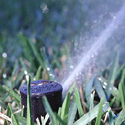Saving Water Using Your Irrigation System
What Does "Calibrating My Sprinkler System" Mean?
Calibrating your sprinkler system means figuring out how long you need to run your sprinkler system to apply the correct amount of water. In most Florida soils, the correct amount is 1/2 to 3/4 inches of water. This rate varies depending on your location in the state. Heavier clay soils, such as in North Florida and the panhandle, may only need the 1/2-inch rate. In sandy soil, which doesn’t hold water as long, you may need to apply the 3/4-inch rate.
How Do I Calibrate My System?
Set out five to ten coffee or tuna fish cans (any straight-sided can will do) around your lawn. If you have an in-ground irrigation system with multiple zones, place the containers in one zone at a time. Scatter the cans at random within the zone. Repeat the procedure in every zone, because there may be differences in how uniformly water is applied in each zone.
If you use a hose-end sprinkler to water your turf, place the cans in a straight line from the sprinkler to the edge of the watering pattern. Space the containers evenly.
Turn on the sprinkler system for fifteen minutes. Then use a ruler to measure the depth of water in each container. The more precise your measurement, the better your calibration will be.
Find the average depth of water collected in the containers. To do this, add up the depths in the different containers and divide that number by the number of containers. This will give you the correct rate in inches per fifteen minutes.
To determine the irrigation rate in inches per hour, multiply the above number times four.
Read "How to Calibrate Your Sprinkler System" for more calibration pointers.
How do I Program My Irrigation Controller?
For instructions on how to program your irrigation system’s controller, see Setting Your Irrigation Controller.
When Is the Best Time to Irrigate?
Early morning is the best time to irrigate (4 a.m. to 8 a.m.). It is cool enough for water to soak into the soil and be absorbed by roots, but it will soon be warm enough for excess moisture to evaporate off the leaf blades. Water that remains on the blades for long periods of time can actually cause turf diseases, so irrigating at night is not a good idea. However, if you cannot irrigate at the ideal time, it’s better to irrigate at night than between 10 a.m. and 4 p.m. Irrigating during this time will waste water because most of it will evaporate without reaching the roots.
Sources
Using the Irrigation Controller for a Better Lawn on Less Water
Let Your Lawn Tell You When to Water
Managing Your Florida Lawn Under Drought Conditions
1 | 2

More Florida-Friendly Landscaping
- Florida-Friendly Landscapes help create a more sustainable Florida. Find out more.

